

More cars with scars
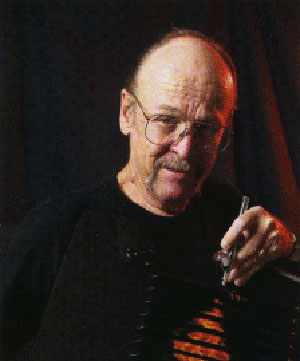 |
One of those I heard from was John Largent, who was a race car painter “back in the day,” who was more than familiar with those works in progress and not a big fan of the unfinished look … for his own reasons.
“Most of the cars you featured were either new bodies being trimmed, prepped, or altered to paint or a patch job in order to make the next contracted match race,” he noted. “While I won't go into names, many times back in the early '70s we worked a couple of straight-through days to get either a Funny Car body in paint with signage because of blowups or blowoffs, and the car we had in the shop wasn't scheduled to be ready on that particular Friday. As a painter, the last thing we wanted was to have a primered or patched body leave the shop, go through four or five passes, and then be brought back to finish; it was almost ‘Go back to square one’ because, back then, after about the third pass on an engine, it was breathing 60 weight and nitro in the lights, and it was everywhere, inside, outside and nearly impossible to get off without using some killer solvents and gassing an occasional prep boy. Your posted photos show a virtual painter's nightmare.
“The only thing worse was to have a customer take an unfinished car, bang a blower, and then bring the pieces back to finish — a worse mess because generally you had burned and broken glass coated with stuff that even a chemist couldn't identify and then, generally, have to hassle with him over the cost of finishing the job. Back then, racers were notoriously cheap; they didn't have big-bucks sponsors and often were just one buck ahead of bankruptcy when everything was going good. Cough a blower or toast some aluminum and what it cost to fix and paint a body became a secondary issue, often going to someone who was trying to break into the field and would do the deal for nothing. Those ‘beginners,’ so to speak, were many but seldom did a lot of them get a second chance or wanted to because of the degree of difficulty in dealing with the logistics of materials — at the time, most of the stuff you had to use wasn't common to auto-paint suppliers — the cost of some, and the fickleness of the car owners, so another reason for some of the ugly cars was the car owner's inability to line up another paint and body guy who'd do it for nothing or really cheap!”
Wow, that’s some really terrific insight into something that I bet few of us ever considered. Thanks, “Large!”
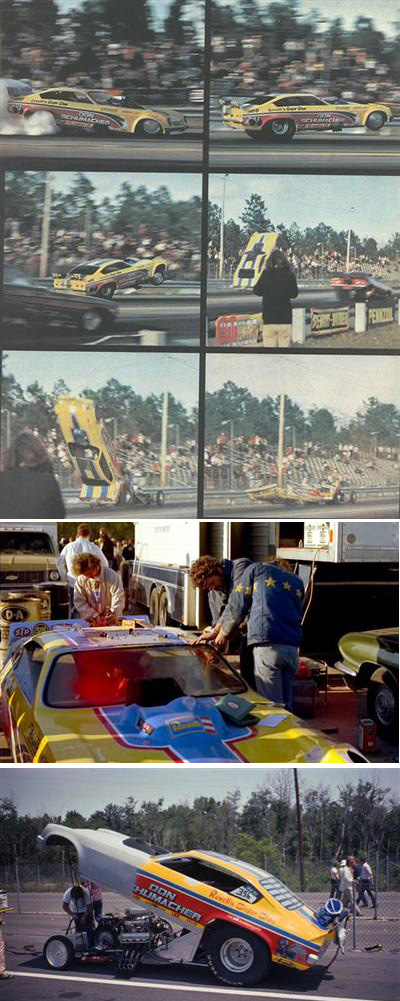 I received multiple emails about Don Schumacher’s Super Shoe Vega and its incident at the 1974 Gatornationals, including several copies of the sequence at right, which appeared in the July 1974 edition of Super Stock & Drag Illustrated that shows the car going into a wheelstand and shedding the body after another wheelstand in qualifying. Two other photos in the gallery showing the team working on the car in the pits are from our pal Tom Nagy and were sent in by Dennis Doubleday. As we know, Shoe’s team repaired the damage and went on to runner-up honors behind Don Prudhomme at the event.
I received multiple emails about Don Schumacher’s Super Shoe Vega and its incident at the 1974 Gatornationals, including several copies of the sequence at right, which appeared in the July 1974 edition of Super Stock & Drag Illustrated that shows the car going into a wheelstand and shedding the body after another wheelstand in qualifying. Two other photos in the gallery showing the team working on the car in the pits are from our pal Tom Nagy and were sent in by Dennis Doubleday. As we know, Shoe’s team repaired the damage and went on to runner-up honors behind Don Prudhomme at the event.
Reader Alan Collums was at the Gators that year and remembered it well. “That was my very first national event,” he wrote. “Shoe left the line on a Saturday qualifier and went into a wheelstand, he pedaled it, landed it, then nailed it again. It came up a bit higher, he pedaled it, landed it, and nailed it a third time, and the body came up and broke right at the rear window area. My guess is that when it landed the second time, it jarred the front latch loose. My brother, Jerry, and I walked through the pits after qualifying was over and saw the teams attacking the body with fiberglass, and we knew they’d have a long night ahead of them.
"Sunday morning, we arrived at the track, and the Funny Cars were in the staging lanes. Walking across the bridge over the lanes, I couldn’t see if Shoe was in the lanes or not. When we got off the bridge, we started walking toward the lanes, and my brother said there SHE is. I thought he said there SHOE is. I was intently looking at the staging lanes, and Linda Vaughn, along with the Hurst Golden Girls, walked right by me! I never saw them!"
You’ll also see a photo of same car taken at the 1974 Summernationals that show the car with significant front-end damage. I grabbed Schumacher for a brief moment during the Finals — he obviously was a very busy man with a bunch of guys in two title fights — but he couldn’t remember what caused the damage. He also said that a lot of teams back in the day had cars with scars due to towing accidents because tie-downs and trailers weren’t quite as state-of-the-art as they are today.
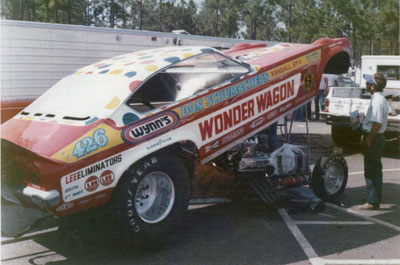 |
Speaking of Schumacher, I had mentioned in a previous column that a pre-Blue Max Raymond Beadle had driven one of Schumacher’s Wonder Wagon Vegas, and reader Tom Strickland was nice enough to send in the photographic proof. This shows the red Wonder Wagon in October 1973 at North Carolina’s Rockingham Drag Strip. You can see Beadle’s soon-famous 426 permanent number on the back (Schumacher was 356).
Although it also was built by John Buttera, you also can see that Beadle’s Wonder Wagon was not as wondrous as the boss’ aero-tricked version. There is no louvered front hood or rear valance, no swoopy injector shield, enclosed side windows, wheel discs, or flow-through front-fender bubbles, and it’s nowhere near as much a lowrider as Shoe’s famous yellow screamer. Beadle and Schumacher first drove Wonder Wagon ’72 'Cudas (also built by Buttera) that were more Wonder Bread-looking with white painted adorned with yellow, blue, and red spots (as were the ill-fated Vega wagons — an attempt to emulate the bread-delivery wagons — that were driven by Kelly Brown and Glen Way but scrapped due to bad handling after just a few runs).
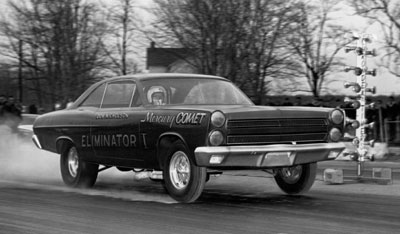 |
Insider regular Jeff Foulk, who wheeled the Finagler A/FC, had his own duct-tape moment, though not nearly as successful as Schumacher’s. “I was at Cecil County Dragway in Maryland one night in the fall of '67,” he remembers. “ ‘Dyno Don’ [Nicholson] was there running a match race. He hadn't been running well, recently, and had changed from the '67 Comet body back to the '66 body, thinking that something in the aerodynamics of the newer body was causing the problem. Ford didn't like the idea, but he did it anyway. It was the third round, and his competition had broken, so 'Dyno' was on a solo to complete the booking. Right before the run, his crew was taping up the inside of the grill area. I can only speculate that they had found cracks in the front of the body. The pits, at Cecil, are up on a hill, so if you stand at the back of the staging lanes, you get a great elevated view right down the track — at least, that’s how it was 40 years ago. 'Dyno' blasted down through, turning 8.00 at 180 mph; a good run. But from the hill, right in the lights, you could see the car rear straight up, like a giant wheelstand. Then we lost sight of it because the lights in the shutdown area were not as bright. It was one of those ‘Did I really just see that?’ moments. I don't think anyone on the starting line saw it because his tow car just leisurely drove down to get him. But, in fact, he had crashed. My guess is the nose of the body caved in, causing the car to fly. It must have been more than just shedding the body because the chassis went over the left guardrail and down into the swamp. They carted him off to the hospital, but he wasn't seriously injured. The car was a different story.”
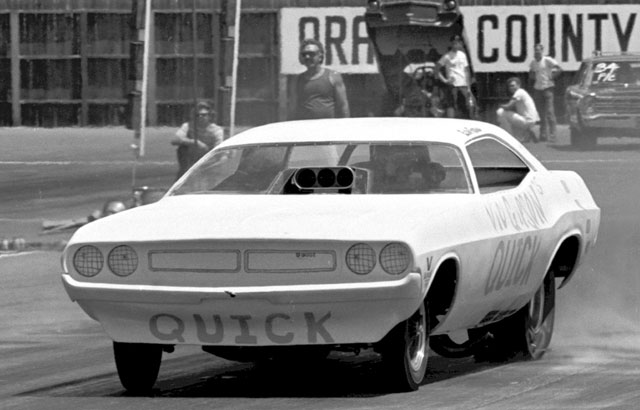 |
I was delighted to hear from Bill Lowery (via snail mail!), who was crew chief for Funny Car racer Vic Gibson from 1970 through 1972, who filled in the details on the Quick Funny Car featured as part of that article.
Lowery confirmed that Gibson always was the owner, and Elgin Freeman was the driver, the first of three hired shoes. The Steve Reyes photo, he says, was the first Saturday after the team changed the nose of the car to resemble a ’72 Challenger. It also was the first weekend after they installed a reverser (“Pushing that heap back to the starting line … gasp. Whew.”).
Fat Bob Colors later painted the car, which was built around a Mike Kase chassis. It followed Gordon Mineo’s ’70 Firebird off the Kase jig but, unlike “Flash’s” car, did not have a dropped front axle; you can see how high the front of the car sits. The engine was a .030-over 392 Hemi backed to a Crowerglide and did not have a transmission until it got the reverser. Lowery remembers the car’s best performance as 6.98, 224.51, and he was with the team until Gibson sold the car in 1972. He notes that Gibson did return to racing with a front-engined C/Econo Dragster in Comp, then a rear-engined car.
“We really can’t forget the people who were there, trying, before Kenny Bernstein took racing corporate; how do you compete with that?” he mused. “Even though we were young, we were still there.”
 |
Also harkening back to an earlier column, Gregory Safchuk sent along the above topless car pic — “One of the coolest,” in his opinion — that show’s Frank Federici’s Rollie Linblad-built The Shark! Corvette from Rhode Island. From its fearsome-looking (though anatomically incorrect) shark teeth in the grille to the cool dorsal fin on the hood and the eyes on the front fenders, Federici definitely had the theme down.

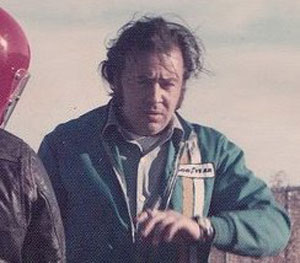 |
I heard from Scott Scrima, son of the recently departed race car-building great Ronnie, who wanted to share this photo as well as some words about his dad. A lot of people had hoped to see him at reunions and such, but that wasn't his way.
“My dad was a very private and I think at times almost shy person,” he said. “He was not into ‘the glory days,’ as it were, but was more into what was going on today. He loved technology, and, as such, felt that drag racing was stuck in sort of a time warp. Electronic fuel injection and computerized tuning aids were something that really fascinated him. He loved drag racing as a sport and would watch on TV, but as far as his involvement was concerned, he was more interested in newer machines. He loved all forms of racing: motorcycle road racing, F1, IndyCars, and, for the pure racing enjoyment, he watched NASCAR. I have so many memories it would take a book. I was there from the 1960s to the present seeing much of it through the wide eyes of a child. Saturday nights at Lions, OCIR, and Irwindale and motorcycles racing at OMS and Laguna Seca. Racing was and still is, after God, my family’s greatest passion in life. After the pride and love I knew he had for it, it was also the greatest gift he ever gave me.”
As I mentioned Friday, Scrima will forever be remembered as the builder of the first Hot Wheels Funny Cars, and Don Prudhomme offered these words of tribute: “In those days, his shop was in Van Nuys, Calif., right next to the airport and across from him was the Milodon shop. He was a real cool guy, and I always loved his name. When I heard the news of his passing, although we only worked together for a few short years, it really affected me. I just want his family to know that it was a good ride, and with me, his memory will always live on."



















































